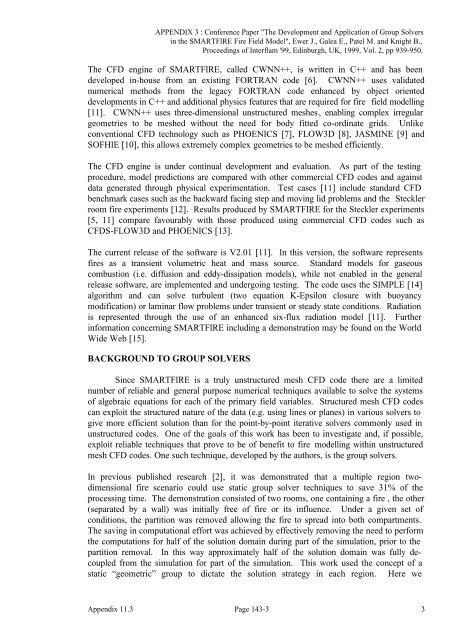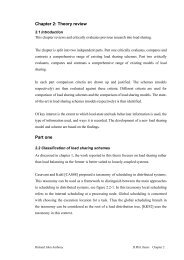PhD Thesis - staffweb - University of Greenwich
PhD Thesis - staffweb - University of Greenwich
PhD Thesis - staffweb - University of Greenwich
You also want an ePaper? Increase the reach of your titles
YUMPU automatically turns print PDFs into web optimized ePapers that Google loves.
APPENDIX 3 : Conference Paper "The Development and Application <strong>of</strong> Group Solversin the SMARTFIRE Fire Field Model", Ewer J., Galea E., Patel M. and Knight B.,Proceedings <strong>of</strong> Interflam '99, Edinburgh, UK, 1999, Vol. 2, pp 939-950.The CFD engine <strong>of</strong> SMARTFIRE, called CWNN++, is written in C++ and has beendeveloped in-house from an existing FORTRAN code [6]. CWNN++ uses validatednumerical methods from the legacy FORTRAN code enhanced by object orienteddevelopments in C++ and additional physics features that are required for fire field modelling[11]. CWNN++ uses three-dimensional unstructured meshes, enabling complex irregulargeometries to be meshed without the need for body fitted co-ordinate grids. Unlikeconventional CFD technology such as PHOENICS [7], FLOW3D [8], JASMINE [9] andSOFHIE [10], this allows extremely complex geometries to be meshed efficiently.The CFD engine is under continual development and evaluation. As part <strong>of</strong> the testingprocedure, model predictions are compared with other commercial CFD codes and againstdata generated through physical experimentation. Test cases [11] include standard CFDbenchmark cases such as the backward facing step and moving lid problems and the Stecklerroom fire experiments [12]. Results produced by SMARTFIRE for the Steckler experiments[5, 11] compare favourably with those produced using commercial CFD codes such asCFDS-FLOW3D and PHOENICS [13].The current release <strong>of</strong> the s<strong>of</strong>tware is V2.01 [11]. In this version, the s<strong>of</strong>tware representsfires as a transient volumetric heat and mass source. Standard models for gaseouscombustion (i.e. diffusion and eddy-dissipation models), while not enabled in the generalrelease s<strong>of</strong>tware, are implemented and undergoing testing. The code uses the SIMPLE [14]algorithm and can solve turbulent (two equation K-Epsilon closure with buoyancymodification) or laminar flow problems under transient or steady state conditions. Radiationis represented through the use <strong>of</strong> an enhanced six-flux radiation model [11]. Furtherinformation concerning SMARTFIRE including a demonstration may be found on the WorldWide Web [15].BACKGROUND TO GROUP SOLVERSSince SMARTFIRE is a truly unstructured mesh CFD code there are a limitednumber <strong>of</strong> reliable and general purpose numerical techniques available to solve the systems<strong>of</strong> algebraic equations for each <strong>of</strong> the primary field variables. Structured mesh CFD codescan exploit the structured nature <strong>of</strong> the data (e.g. using lines or planes) in various solvers togive more efficient solution than for the point-by-point iterative solvers commonly used inunstructured codes. One <strong>of</strong> the goals <strong>of</strong> this work has been to investigate and, if possible,exploit reliable techniques that prove to be <strong>of</strong> benefit to fire modelling within unstructuredmesh CFD codes. One such technique, developed by the authors, is the group solvers.In previous published research [2], it was demonstrated that a multiple region twodimensionalfire scenario could use static group solver techniques to save 31% <strong>of</strong> theprocessing time. The demonstration consisted <strong>of</strong> two rooms, one containing a fire , the other(separated by a wall) was initially free <strong>of</strong> fire or its influence. Under a given set <strong>of</strong>conditions, the partition was removed allowing the fire to spread into both compartments.The saving in computational effort was achieved by effectively removing the need to performthe computations for half <strong>of</strong> the solution domain during part <strong>of</strong> the simulation, prior to thepartition removal. In this way approximately half <strong>of</strong> the solution domain was fully decoupledfrom the simulation for part <strong>of</strong> the simulation. This work used the concept <strong>of</strong> astatic “geometric” group to dictate the solution strategy in each region. Here weAppendix 11.3 Page 143-3 3




